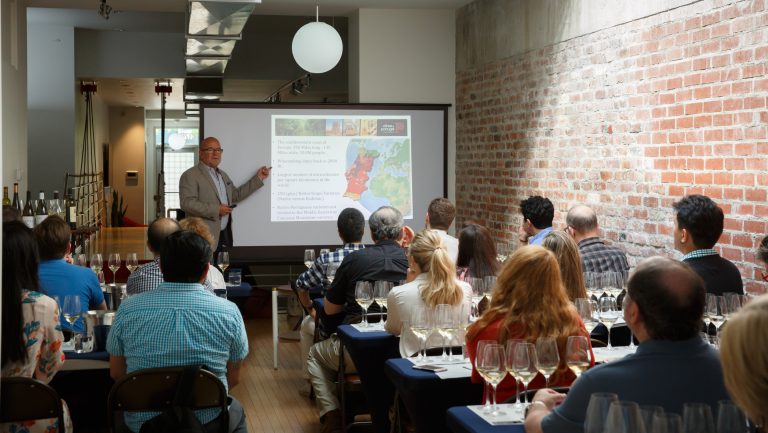This advertising content was produced in collaboration with our partner, Vin de France.
Wines from France have always enjoyed a special status among buyers and consumers in the United States, often representing the pinnacle of quality and traditional winemaking styles. Today, the Vin de France (VDF) category expands the possibilities of French wines by encouraging creativity, freedom of expression, and the production of genuine, sustainable wines.
The category, which allows vintners to blend grape varieties from across regions in France, is centered upon giving winemakers freedom and creativity in their winemaking choices. Rather than forcing producers to rely on their geographic region’s historically relevant grapes or borders, the VDF label encourages unrestricted interpretations of French savoir faire.
VDF wines can likewise be made of any grape variety or blend. Since the VDF classification was created in 2009, over 820 vintners have embraced the liberty to reimagine the varietal wines and blends they are able to produce, making VDF wines one of the most diverse categories on the market today.

Don’t miss the latest drinks industry news and insights. Sign up for our award-winning newsletters and get insider intel, resources, and trends delivered to your inbox every week.
The wines themselves, which often feature their grape variety directly on the front label, appeal openly to New World drinkers accustomed to choosing wine according to grape. Omitting regional appellations allows drinkers to experience French wines without getting bogged down in specific labeling terminology, which contributes to the approachable nature of VDF wines. For both buyers and consumers, the value is obvious: Wines with all the prestige of their country of origin, yet the ease to simply purchase and enjoy.
Volume and Value Growth
According to SevenFifty marketplace data, the average wholesale price of a bottle of VDF wine was $25.19 in 2021, a 2.7 percent increase over 2020, making VDF wines some of the top-value bottlings being exported from France today. Though VDF wines have seen steady growth since 2013, the sector has experienced significant development in both on- and off-premise settings in the past two years.
On SevenFifty, the search appearance share of VDF wines across the marketplace grew from 0.83 percent in 2020 to over one percent in 2021. The size of the VDF catalog on Sevenfifty likewise expanded: In 2021, the number of VDF SKUs grew by 65 percent to represent a catalog of 7,743 products. The rising availability of VDF SKUs has also contributed to more ordering among buyers; the number of VDF SKUs ordered on SevenFifty rose by 43 percent, suggesting buyers are taking action to provide their customers with these in-demand French wines.
According to French export data, VDF wines now account for 15 percent of French still wine exports by volume in the world, a massive amount considering the relative youth of the category. VDF wines also comprise 12.6 percent of total French still wine exports to the U.S.
In recent years, varietally labeled VDF wines have driven growth for the category within the U.S.; in 2021, the country was the number one export market in value for VDF wines with the grape variety stated on the label, accounting for over 1.3 million cases of wine—a 33 percent growth over 2020.
Inside the Varieties Driving VDF
Wines of all styles and colors are produced within the VDF designation, and a number of grape varieties from across the country make up the wine spectrum of these French wines. On SevenFifty, Grenache and Syrah were top sellers in 2021 in terms of value, with both varieties seeing gains over 2020.
However, Pinot Noir and Merlot remain important red grapes for VDF producers, and both varietal categories experienced significant sales growth on SevenFifty over 2020. Sales value of Merlot increased by over 77 percent, while Pinot Noir’s sales more than doubled from 2020 to 2021. This suggests that buyers are embracing the value and quality they can find in these French wines from popular grape varieties.
Among white wines, the most popular varieties for VDF producers on SevenFifty are Chardonnay and Sauvignon Blanc. In 2021, Chardonnay actually surpassed Sauvignon Blanc among SevenFifty buyers of VDF wines, though both experienced strong sales gains.
Both red and white wines experienced major category growth in 2021, with sales of VDF red wines growing by 40 percent and sales of VDF white wines nearly doubling. Rosé VDF wines, however, remained relatively flat, suggesting buyers are increasingly exploring outside of the pink wine spectrum.
Where Are VDF Wines Gaining Popularity?
Moving into 2022, VDF wines are continuing to gain momentum with both on- and off-premise buyers. Off-premise retail establishments continue to dominate VDF wine purchasing, accounting for over $1.3 million in sales on SevenFifty in 2021—a 35 percent increase over 2020. The value of VDF wines at retail is obvious: Their easy-to-read, easily understood labels prominently feature grape varieties rather than potentially unfamiliar appellations.
In on-premise settings, VDF wines make up a smaller share of sales—accounting for roughly $400,000 in 2021—but experienced a whopping 77.4 percent growth in 2021 over 2020. While this is partially due to the rebounding of the on-premise sector post-pandemic shutdowns, it also suggests that wine buyers and sommeliers are interested in showcasing these wines to their patrons, particularly through by-the-glass pours.
VDF wines follow established purchasing trends, experiencing year-end gains during the holiday season when wine buying traditionally increases. In Q4 of 2021, VDF wine sales doubled 2020 totals over the same time period on SevenFifty. This trend indicates not only the potential of VDF wines as gifting and holiday party staples, but shows that as prices rise for other popular wines, VDF wines continue to deliver.
The freedom and accessibility offered by VDF wines is unique, not only in the creativity it inspires among vintners but in the approachability offered to consumers. The diversity built into the DNA of VDF wines will likely continue to push the category forward among buyers and consumers, confirming creativity and freedom are winning attributes—even in a bottle of wine.

Dispatch
Sign up for our award-winning newsletter
Don’t miss the latest drinks industry news and insights—delivered to your inbox every week.









